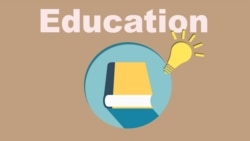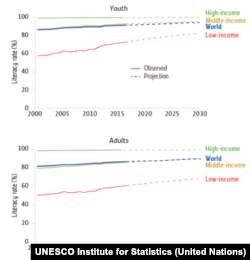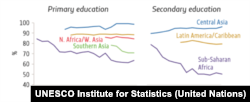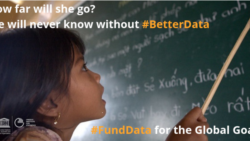Children entering school now should finish secondary school by 2030. But if current trends continue one in six will not be in school in 2030 and only sixty percent will be finishing their secondary education.
Leaders are meeting from July 9 through July 18 at the High-Level Political Forum (HLPF) – the United Nations' official platform for examining the 2030 Agenda for Sustainable Development. They will be measuring progress on education for the first time since 2015.
Silvia Montoya is Director of the UNESCO Institute for Statistics and Manos Antoninis is Director of the Global Education Monitoring Report. They say the world does not seem close to meeting the Sustainable Development Goal for education ("SDG 4") – which aims for all girls and boys completing free, fair and high-quality primary and secondary education - by 2030. So, the two experts say, “business as usual for education must come to an end.”
If the goal is not met the world will have failed a generation of children, they add.
A new report from their groups tells about progress toward each SDG 4 education target, from early childhood education to adult literacy. Montoya and Antoninis say that the world’s countries need to make some changes to meet education goals.
Get children into school
Starting children’s education with preschool is best, the report says. This helps older children attend school. In many countries, more children are in early childhood programs. But in poor countries, the number of children aged six -17 who are not in school has gone down. In 2030, 16.7 percent, or 225 million young people, will not be in school.
Help children complete secondary school
The experts say children also must be supported in completing secondary school. The goal of all children completing primary school was set for 2015, but it will not be met by 2030. The percentage of children completing secondary education in low-income countries is less than half of the world-wide rate.
Deal with earnings inequality
Differences in earnings lead to big differences in education. Four percent of children from the poorest families complete upper-secondary school in low-income countries. Just two percent of the poorest girls -- compared to 36 percent of those from the richest families -- complete upper-secondary school. The UNESCO officials say earnings inequality must be dealt with.
Push for reading and raise learning ability
Montoya and Anoninis note a strong connection between reading ability and learning rates. Around 20 percent of youth and 30 percent of adults will still be unable to read in low-income countries by 2030. Learning rates will not increase in middle-income countries if reading ability rates remain the same. In French-speaking African countries, rates will drop by almost one-third in 2030.
Increase spending
One in four countries does not meet two of the SDG 4 goals. One is to provide at least 4 percent of Gross Domestic Product (GDP) on education. The other is to use 15 percent of their total government spending on education. Financial support for education has not grown since 2010, the report says. Contract employees are replacing trained teachers in sub-Saharan Africa, hurting the quality of education. Countries need to find and train more teachers.
Collect and examine more information on education
More data is needed to supervise progress in education. Montoya and Antoninis say that “data are a necessity – not a luxury – for every country, which is why partners are making the call to #FundData.”
The UNESCO report authors ask the international community meeting in New York this week to compare their plans for the next ten years with their earlier promises.
Montoya and Antoninis said they hope that the world leaders will “hear this warning” and act to meet the still possible development goal.
I’m John Russell. And I’m Jill Robbins.
Jill Robbins adapted this story for Learning English based on UNESCO report for the World Economic Forum. Caty Weaver was the editor.
________________________________________________________________
Words in This Story
sustainable – adj. able to be used without being completely used up or destroyed
equitable – adj. just or fair : dealing fairly and equally with everyone
generation – n. a group of people born and living during the same time
commit – v. to say that (someone or something) will definitely do something
literacy – n. the ability to read and write
challenge – n. a difficult task or problem
















